Italian Regional Lunch
Tutto Gusto Wine Cellar
Wednesday, November 7, 2012
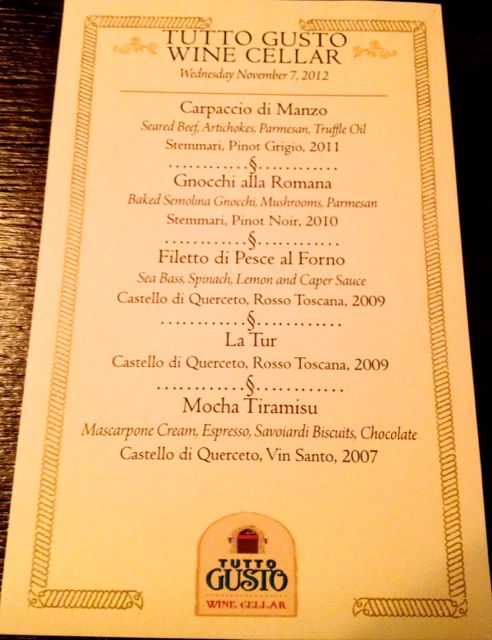
Menu for today’s Italian Regional Lunch (it changes every week)
Tutto Gusto is a bar during the day and a bar + the full Tutto Italia menu at night. We’ve been here a few times right after they first opened (here and here), when we’ve seen what’s been happening to the menu, we weren’t inclined to come back (they removed the pick and choose meats and cheeses and now serve more “americanized portioned meals” – humph!).
When we heard that Lisa and Andy were coming to the Epcot International Food & Wine Festival, this was one of the events that the four of us were interested in trying (it’s the first year for the Italian Regional Wine Lunch, they usually happen in France). We were called in to our table in the second group and promptly seated. After being seated, we were given focaccia and olive oil for dipping it in (the servers keep the slightly warm bread coming throughout the meal). The olive oil was rather green tasting and nick commented that the focaccia nora used to make was much better than this version. There were empty tables (quite a few empty seats actually) at our event the last week of the Food & Wine Festival.
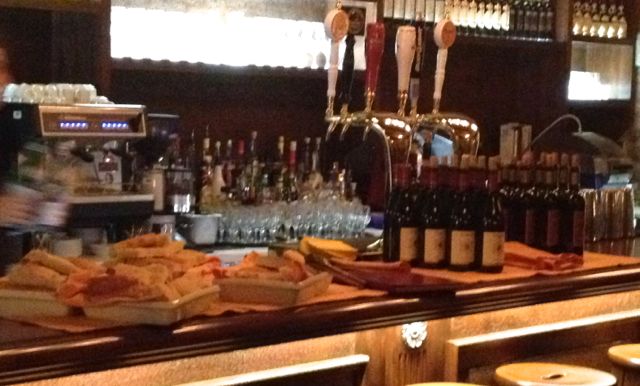
Bread and wine waiting on the bar
Dan Parrot recently became the sommelier for all of the venues in the Italy Pavilion, he began the luncheon by explaining that we were going to be breaking the red wine/meat and white wine/fish rule throughout today’s menu.
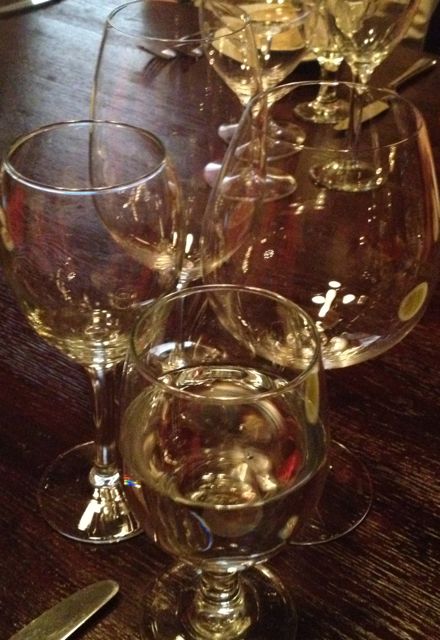
Stemmari, Pinot Grigio 2011
The first wine was a Pinot Grigio. Steve was the importer representative… Stemmari wines are from Sicily (Stemmari means “crest of arms”) and that Sicily produces more wine than the rest of Italy combined. Why are Italian wines so hard to learn? Steve says it’s because wine started in Italy, so they’ve had a lot more years to make it complicated. Steve said that the nose should be green apple, the primary taste should be acid; both of these are due to the hot climate where the grapes are grown and the high alcohol content.
Tasting Notes without food… it smells like Pinot Grigio and the taste is very tart, sharp even without food. The focaccia helps the wine somewhat, it smoothed it out a bit. After the Pinot Grigio warmed up a bit, the flavor improved.
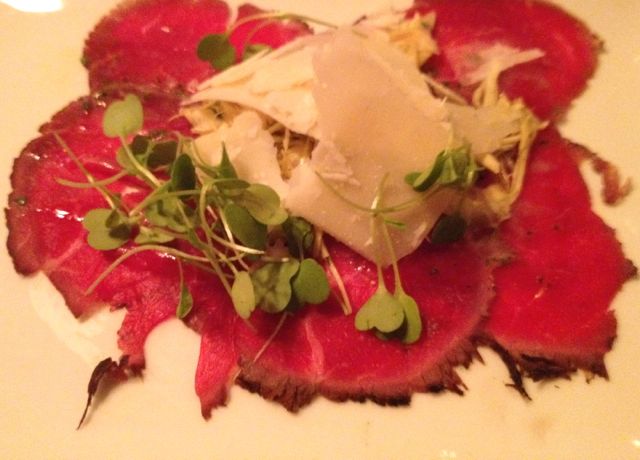
Carpaccio di Manzo
The first food pairing was the Carpaccio di Manzo – Seared Beef, Artichokes, Parmesan, and Truffle Oil. Nick thought that the pairing was fine, the wine stands well by itself but the food doesn’t. Nora agreed that the pairing works well, but she wasn’t horribly fond of the Pinot Grigio with or without food, although it tastes better than the other Pinot Grigios we’ve tasted.
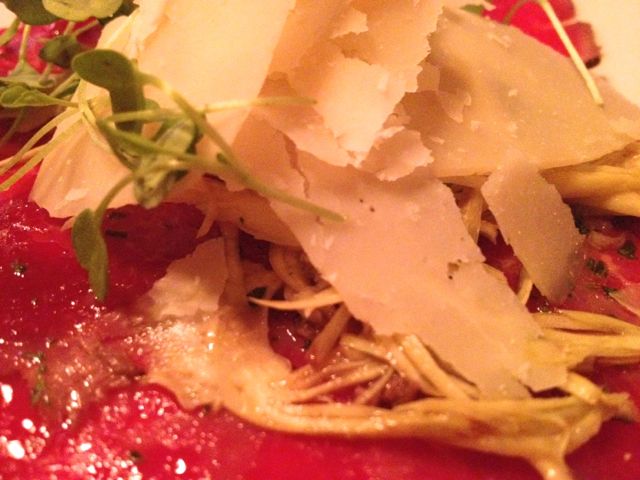
The artichokes were finely julienned into a “slaw” and the parmesan cheese flakes were large enough to taste on their own
The slivered artichokes were particularly good.
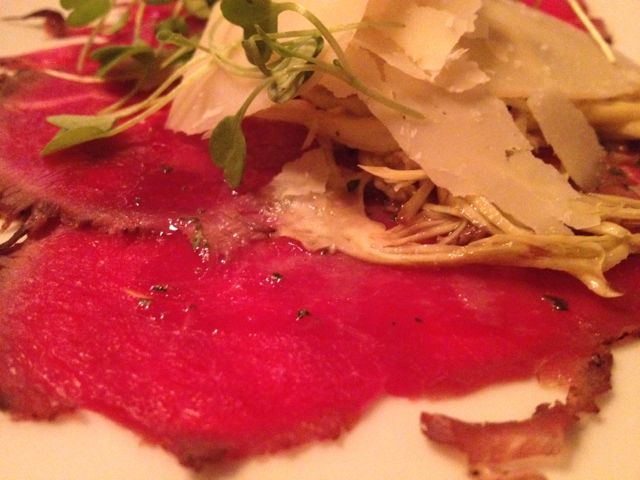
The beef was tender and the truffle oil wasn’t overpowering (actually, it wasn’t really discernible)
The beef was pretty flavorless on it’s own.
The second wine was the Stemmari Pinot Noir 2010. Steven said that the pinot noir is a hard grape to produce because it grows in tight bunches and is very susceptible to mold, typically. This isn’t as much of a problem in the hot dry Sicilian climate.
Tasting notes without food… the nose was lots of berry and cherry; the taste was rich, yummy, cherry; pleasant; tasting it with the bread and olive oil produced too much tannin flavors; as it warmed, liking it less.
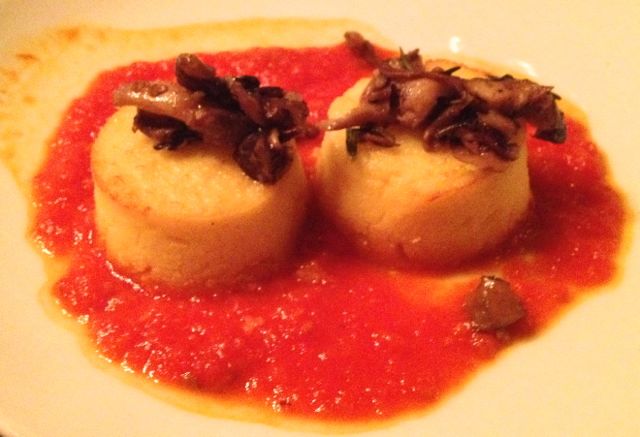
Gnocchi alla Romana
The second food pairing was Gnocchi alla Romana – baked semolina gnocchi, mushrooms, and Parmesan. Nick thought that the wine went best with the mushrooms, but he deemed that as only tolerable; he felt that the wine didn’t go with the tomato sauce or the semolina at all. The two best components of the food were the tomato sauce (simple and good) and the mushrooms. In general, he thought that this wine was “eh” and the dish was “eh.”
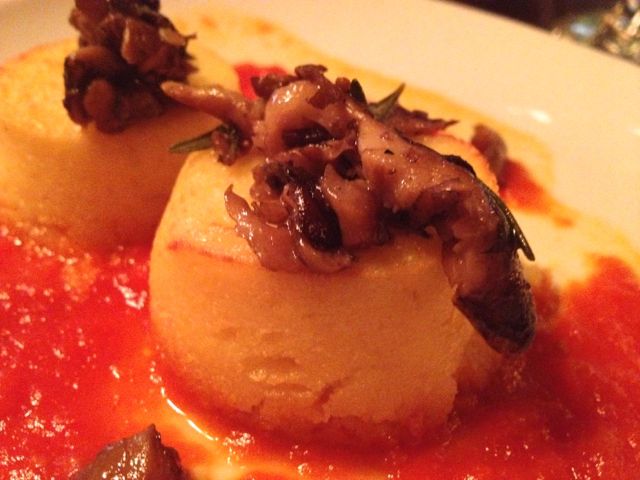
The “gnocchi” were more like small creamy rounds of polenta (although polenta is corn and these were wheat)
Nora liked the tomato sauce and the wine together, she was particularly fond of the tomato sauce (it tastes like her Granny’s tomatoes and macaroni). When tasting everything all together with the wine, there was just too much tannin for her tastes. The mushrooms were quite good, but the semolina gnocchi wasn’t anything special. Neither of us detected any parmesan in this dish.
The third wine was paired with the fish course and the cheese course, it is usually called a “dago red” (simple classic Italian red wine) – specifically, this was Castello di Querceto Rosso Toscana 2009. Steven said that this wine is specifically blended for the American palate. This is the third vintage and isn’t available retail. There should be hints of green and white pepper. It’s aged for 14 months in small new Tuscan oak barrels… expect that it will have a 12 to 15 year shelf life.
Tasting notes without food… nora says it has a spicy and peppery nose and tastes chalky. Nick says that the taste is rich, not as chalky as the previous red, however it’s too dry to drink without food.
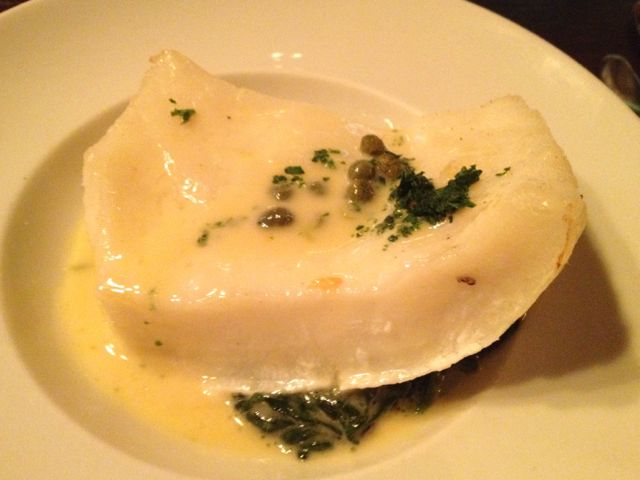
Filetto di Pesce al Forno (baked fish fillet)
The fish course was Filetto di Pesce al Forno – sea bass, spinach, lemon, and caper sauce. Nick’s fish was overcooked on the edges. He though that the pairing was nothing special, the fish in particular would have benefited from a little seasoning during the cooking process (it was bland!).
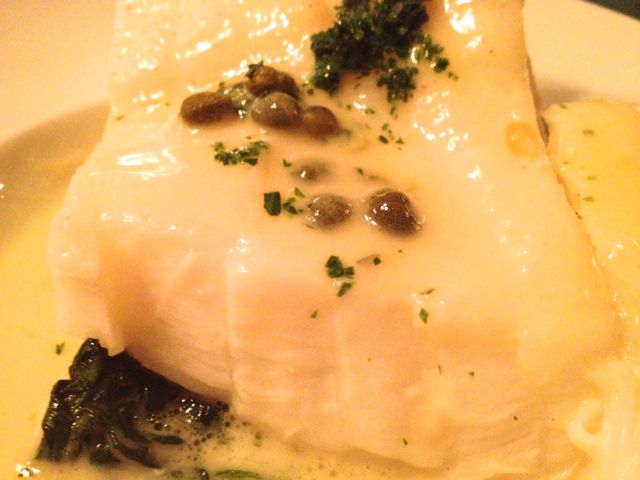
The spinach and the caper sauce were the two best parts of this dish
Nora liked the lemon on the fish, but found the fish itself to be too chewy and lacking in seasoning – all of the salt and flavor was in the sauce and the spinach. The pairing with the wine, well it wasn’t a pairing – neither contributed anything to the other.
The cheese course, La Tur, was paired with the Rosso Toscana also.
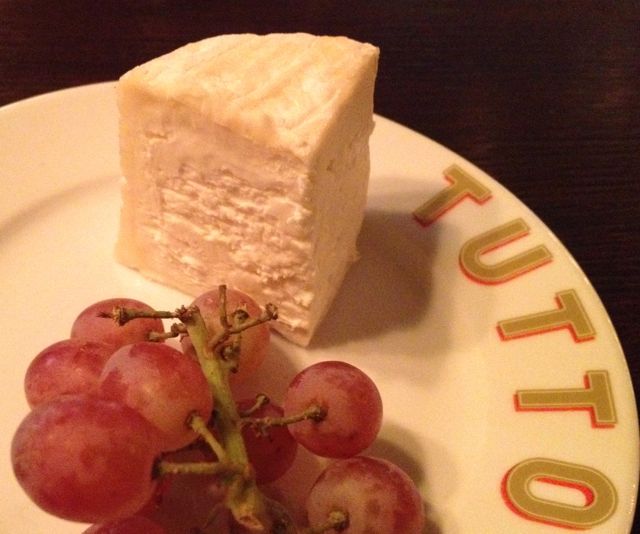
La Tur – the cheese course
Nick didn’t “get” the pairing, that is he didn’t think this very rich (but not very flavorful) cheese did anything to enhance the wine or vice versa. In fact, he didn’t think that the Rosso Toscana paired well with either course.
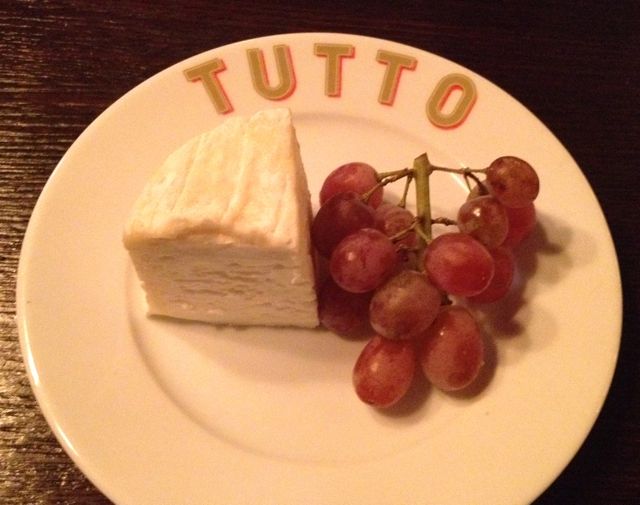
Sad little grapes with the cheese
Nora thought that the cheese was very slightly funky, but not like brie; the texture was very much like cheesecake and the wine didn’t pair at all. Must agree with nick that the Rosso Toscana didn’t pair well with the fish or the cheese.
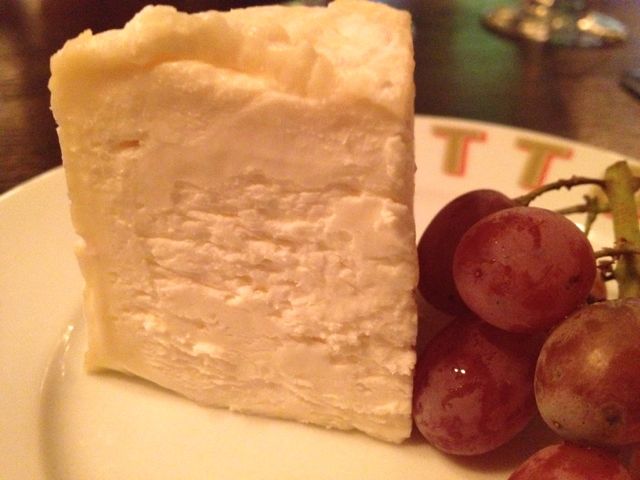
the texture of La Tur is like a true cheesecake
The final wine was Castello di Querceto Vin Santo 2007. Steven told us that Vin Santo, meaning “Saint’s Wine”, takes seven times as many grapes to create, thus it’s very expensive and rare (about 90 cases of 500mL bottles per year, we have 1/2 case here today; we did not get refills of this one). The grapes are dried into raisins (not on the vine), the wood fires used to dry the grapes add a slight smokiness, and the wine is barrel aged in very small, very old Tuscan oak casks. Vin Santo is a dessert wine. Nick thought that the vin santo without food was very “port” like and interesting, nora thought it tasted like a sweet wine with some raisiny notes.
The dessert course was Mocha Tiramisu – mascarpone cream, espresso, savoiardi biscuits, and chocolate.
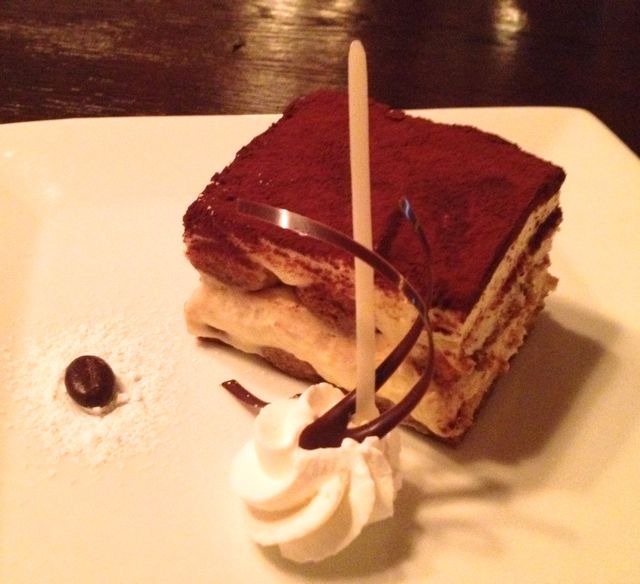
Mocha Tiramisu
Nora liked the pairing of this dessert with the wine, she almost never eats tiramisu because of the caffeine in espresso. We both thought that the tiramisu was quite tasty, nick would have preferred a good cup of coffee with it rather than dessert wine.

interior of Tiramisu
It was nice to do something new and different. We think that these “large” events (signature dinners, culinary adventures (here and here) regional wine lunches, party for the senses, and the dessert discovery party) are going to be “one a year” events for us in the future.
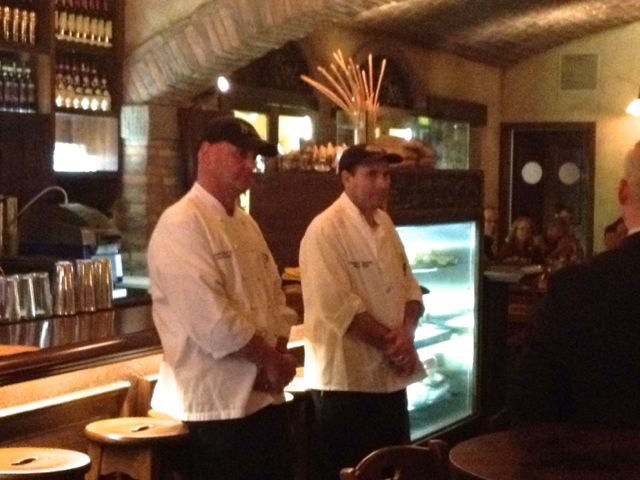
The Chef and the Pastry Chef – Thank you!